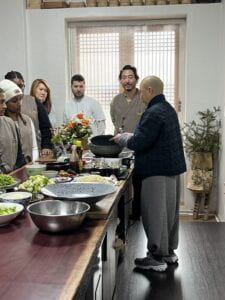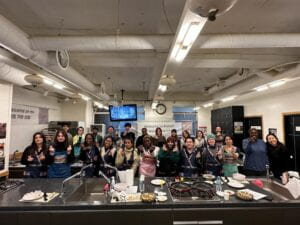By Duncan Yoon
This Albert Gallatin Scholars trip took one of the most salient aspects of any culture — cuisine — and used it as a point of departure to explore social and historical contexts. The emergence of Korean culture on the global scene in the past few years lent the trip a contemporary relevance that enabled the students and trip leaders to examine how South Korea has become part of new patterns of globalization that are not just linked to its relationship with the West, and the United States particularly. We traveled across the country, from Busan to Seoul, making many stops to consider regional cuisines, political movements, and art scenes. In what follows I will give a brief overview of some of the highlights of the trip.
Our first stop right after we arrived at the Incheon airport was to hop on a bus to Baekyangsa, a Buddhist temple in the central part of the country that is not only famous for its use by political dissidents and disenfranchised politicians but also for its being the main temple for the famous Buddhist nun chef, Jeong Kwan. Jeong Kwan has become a veritable culinary superstar in the past few years, exemplified by an episode on Netflix’s Chef’s Table. During our temple stay, the students were fortunate enough to have an entire meal cooked for them by her and her kitchen staff.
As each dish came out, Jeong Kwan spoke to the students about her philosophy of cooking and how it was, in fact, not just a material, but in many ways, primarily a spiritual endeavor. Jeong Kwan strives to cook foods in a way that allows the natural flavors of the vegetables she prepares to be amplified, rather than hide them through a preponderance of spices. Throughout the meal, it became clear that for Jeong Kwan food was not just sustenance, but was a path towards self-realization.
We then stopped in the city of Gwangju where we explored independence movements, and art exhibitions, and, in particular, visited the Naju Student Independence Memorial Hall where the students learned about youth resistance against the Japanese Occupation. We also had what was perhaps our most memorable dining experience: hongeo or fermented skate. This fish is one of the most divisive dishes in Korean culture, with half the population hating it and the other half loving it. I was impressed by how game the students were to try this pungent, almost bordering on acrid delicacy. Although most of us could not make it through all of the dishes, the experience proved to be one of the most important bonding moments of the trip.
We then made our way to Busan, South Korea’s “second city” where we ate wheat noodles inspired by the importation of wheat from the U.S. during the Korean War. We considered the relationship between history and how a dish can explicitly reflect a political moment and how necessity is indeed the mother of invention. We also spent time at the Provisional Capital Memorial Hall, which served as the seat of the Korean government when Busan was the only part of the entire peninsula not occupied by Chinese and North Korean forces. One of the most powerful stops was at the UN Memorial Cemetery where the many soldiers who lost their lives during the war are buried. I, in particular, will always remember accompanying our Assistant Dean of Global and Community Programs, Mehmet Darakçiolu, to the Turkish section of the memorial where he paid homage to the Turkish soldiers who had died in the war.
We then got on the high-speed bullet train to Seoul, where we spent many days exploring the city — everything from the royal palaces to prison memorials. We also had the opportunity to take a cooking course at the Sejong Cooking Academy, during which the students learned how to make one of the most classic staples of Korean cuisine, bulgogi. One of the best parts of the trip was experiencing how to cook Korean food, a wonderful exercise in one of Gallatin’s main pedagogical foci: experiential learning.
Many students remarked how they were going to cook this dish for their friends and family upon their return so that they could share with them a bit of their time in Korea. We also made our way to the Kimchi Museum, where the students learned about the long and complex history of Korea’s most important food. In addition to learning the mechanics of fermentation, we also learned how before the Western imperial period, kimchi was, in fact, not spicy! It was only with the importation of chilis from Latin America that this all-important dish assumed its quintessentially spicy flavor.
One final highlight I will mention was the trip we took to Paju to see the infamous Demilitarized Zone or DMZ. We took trolleys down into the underground tunnels that the South Koreans had made to intercept North Korean attempts to invade the country. Although we had spent most of the trip moving in between history and culture, the fact that North Korea and South Korea are the only two countries still fighting the Cold War made a strong impression on the students. South Korea’s emergence as a cultural powerhouse in the 21st century must be understood against the backdrop of an unceasing war, a war that has divided a peninsula that had been more or less unified for almost a thousand years.
All in all, the trip was packed with memorable events and experiences — many of which I, as well as our students, will never forget. AGS Scholars, Fighting!



